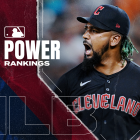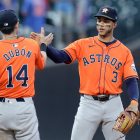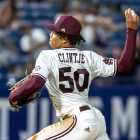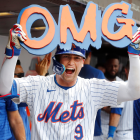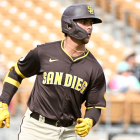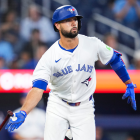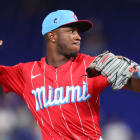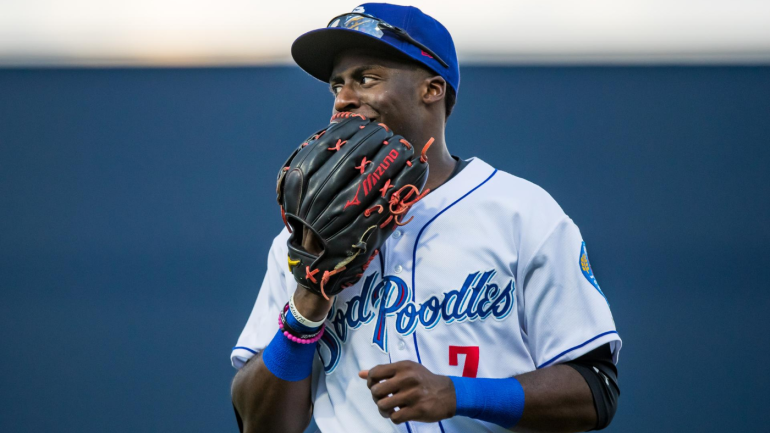
Major League Baseball's 2020 trade deadline passed at 4 p.m. ET on Monday afternoon. Although it wasn't the standard deadline, a number of interesting moves were made and a lot of prospects were traded in the process. Because some fans might not be familiar with the youngsters, we've taken it upon ourselves to educate folks about their team's additions.
Below, you'll find a ranking of every prospect traded since Aug. 21 (note that this does not include players who have exhausted their rookie eligibility), along with information we've gathered after talking with scouts and executives about each player.
Obviously the ranking itself is subjective (and these things become a series of coin flips after a certain point), but the intent here is to educate, to entertain, and to provide a snapshot in time of how these players were perceived at this moment in time.
1. Taylor Trammell, OF, Mariners
Acquired: from the Padres for C Austin Nola and RHPs Austin Adams and Dan Altavilla
Trammell was also involved in a big trade last deadline, having been sent from the Reds to the Padres as part of the three-team swap that also involved Trevor Bauer and Yasiel Puig. The change of scenery didn't help much. His strikeout and walk rates darted in the wrong direction, and he finished the season with a slash line of .234/.340/.349 in more than 500 Double-A plate appearances. Trammell, who won't turn 23 until September, has garnered comparisons to Brett Gardner thanks to his on-base skills and defensive upside in left field. Some evaluators have wavered on his chances of living up to his promise, however, because of his well-below-average arm and his perceived inability to play center field or make adjustments.
2. Connor Seabold, RHP, Red Sox
Acquired: from the Phillies for RHPs Brandon Workman and Heath Hembree
The surest way for a prospect's stock to improve is to get traded to a team generally managed by Chaim Bloom. Case in point: Seabold has ascended from an obscure, overage starter to … well, ranking highly on this list. Depending on who you ask, the hype is justifiable. Seabold's rising fastball grades better using Trackman than the eye test, and his improved changeup gives him a second average or better secondary offering. Factor in his command, and he seems like a decent bet to outpitch the sum of his parts. Some teams had Seabold ranked as one of the Phillies' five best prospects, and while that might say more about the state of their farm system than his actual potential, he should be able to slot in as a mid-to-back-end starter within a year.
3. Gabriel Arias, SS, Cleveland
Acquired: from the Padres for RHP Mike Clevinger, OF Greg Allen, and a player to be named later
Arias, who will be 20 until February, was nearly four years the junior to the average Cal League player last season when he hit .302/.339/.470 with 17 home runs there. He's a fluid defender who should stick at the shortstop position, and he has a chance to be a "cheap" five-tool player -- meaning he could have five average or better tools, not five elite tools. The proverbial fly in the ointment is Arias' approach. There's reason to believe he's improved his judgement over the past year, but he also struck out more than five times as often as he walked last season. There's a slim chance Arias develops into a star. He's more likely to be a decent regular.
4. Terrin Vavra, INF, Orioles
Acquired: from the Rockies for RHP Mychal Givens
Vavra batted .318/.409/.489 with 43 extra-base knocks and as many walks as strikeouts in his first full professional season. Evaluators still have concerns about elements of his game, including his long-term defensive home and his lack of a carrying tool. There's a chance that Vavra reaches maturation with four tools (everything except power) that grade as average or better, but that none of his tools qualify as plus. Those who are more forgiving of his perceived blemishes (perhaps because of his feel for the game), could envision him becoming a second-division starter. Everyone else will see him as a reserve, and maybe a deep one.
5. Edward Olivares, OF, Royals
Acquired: from the Padres for RHP Trevor Rosenthal
Olivares made the leap from Double-A to the Padres' Opening Day roster. He looked overmatched in the 36 plate appearances he took prior to a demotion, as he struck out 39 percent of the time and recorded an average exit velocity in the mid-80s. Whatever. He has a number of average-ish tools, and he should slot in as a reserve outfielder, if not a touch more. (The Padres, by the way, originally acquired Olivares in a trade for Yangervis Solarte. Nifty.)
6. Riley O'Brien, RHP, Reds
Acquired: from the Rays for LHP Cody Reed
O'Brien remains a work-in-progress despite 1) requiring Rule 5 protection beginning this winter and 2) turning 26 early next February. He's tall and lanky, and he's gained velocity on his promising fastball-breaking ball combination in recent years. That he hasn't made the same progress with his changeup or his control has led many evaluators to peg him as a future reliever. If O'Brien does find a way to stick in a rotation, this will prove to be an underrank.
7. Joey Cantillo, LHP, Cleveland
Acquired: from the Padres for RHP Mike Clevinger, OF Greg Allen, and a player to be named later
Cantillo has been peddled around the league dating back to last deadline, when the Padres attempted to capitalize on his brilliant run in the Midwest League. He was (and remains) a polarizing prospect because of his substandard fastball and breaking ball. Cantillo's boosters will point to his youth (he won't turn 21 until Christmastime) and size (he's listed at 6-foot-4, 220 pounds) as reasons the best is yet to come. That's to be determined. For now, Cantillo does have a good changeup, a deep release point, and a deceptive delivery working in his favor. The range of outcomes here includes everything from mid-rotation starter to organizational depth.
8. Stuart Fairchild, OF, Diamondbacks
Acquired: from the Reds for RHP Archie Bradley
Here's what we wrote about Fairchild earlier in the month, when we named him as a prospect who could be on the move before the deadline: "At worst, Fairchild would be a fine fourth outfielder. He can do a little bit of everything, including playing center, and he's shown an aptitude for improving, demonstrating as much by learning to lift and pull the ball more frequently since turning pro."
9. Hudson Potts, 3B, Red Sox
Acquired: from the Padres for 1B Mitch Moreland
Potts is the most popular of the players acquired by the Red Sox. He was selected 24th overall in the 2016 draft, ahead of names such as Will Smith, Dylan Carlson, and Dakota Hudson. Alas, this Hudson hasn't had an easy path to the Show. He's struck out in 30 percent of his 537 Double-A plate appearances because of an undiscerning, pull-happy approach. Potts does have well-above-average power potential, and the Padres' experimentation with him at the keystone provided him with a touch more defensive value. The Red Sox are hoping they can unlock his offensive upside; if they do, he's a potential regular. Otherwise? He might not make it.
10. Jeisson Rosario, CF, Red Sox
Acquired: from the Padres for 1B Mitch Moreland
Rosario is a high-grade athlete with the wheels and arm to double as a human highlight reel in center. His development at the plate will determine if he's more than a spare outfielder. He hit .242/.372/.314 last season in High-A, with his on-base percentage being buoyed by an absurd walk rate that neared 17 percent. It sounds counterintuitive, but his walk-reliant approach is a red flag. For one, advanced pitchers won't give in to low-wattage batters; for another, it raises questions about Rosario's approach, and whether he's too passive or defensive up there. He could become a starter if the Red Sox are able to help him become more menacing at the dish.
11. Lucius Fox, SS, Royals
Acquired: from the Rays for OF Brett Phillips
Fox has had a presence in prospecting circles since 2015, when the Giants paid him a $6 million signing bonus. (San Francisco sent him to the Rays in the Matt Moore trade a year later.) It's fair to describe his aesthetic as "Royals-y." He's fast and he can defend the shortstop position, but he doesn't have much strength and he's a nominal switch-hitter who is better against left-handed pitching. Sounds like a reserve to us. Fox just turned 23 in July, and he has options remaining, so there's time left for him to improve that projection.
12. Tyler Nevin, 1B, Orioles
Acquired: from the Rockies for RHP Mychal Givens
Nevin had a successful 2019 season in one (and perhaps only one) regard: he played in a career-high 130 games. What he did in those games was less encouraging, as he hit .251/.345/.399 in Double-A. Nevin, who has always walked and kept his strikeout rate in check, did a better job last year of pulling and lifting the ball, but those changes didn't result in a greater power output. Because he's a right-right corner player without a good glove, he's going to have to hit (and then hit some more) in order to stick in the Show, likely as a reserve.
13. Gerardo Reyes, RHP, Angels
Acquired: from the Padres for C Jason Castro
Reyes has some innate traits that should help him improve his career ERA from 7.62 when and if he receives further opportunity. During his 27-game stint in the majors last year, he threw an upper-90s fastball that showed good rise. His lower arm slot creates a flatter angle when he elevates the heater, which makes him appealing to teams who prioritize vertical approach angle. Reyes has shown some promise with his slider as well. Should he find more consistency, particularly with his command, then he should find a long-term home in the late innings.
14. Owen Miller, INF, Cleveland
Acquired: from the Padres for RHP Mike Clevinger, OF Greg Allen, and a player to be named later
Miller spent last season in Double-A, where he batted .290/.355/.430 with a career-high 13 home runs. The power uptick appears to be a product of a friendly hitting environment more so than a meaningful tweak to his swing or approach. He does have quality bat-to-ball skills, though, and he's an average or better runner (even if his mobility hasn't shown up in the stolen-base column). On defense, his arm is stretched thin on the left side of the infield, making him a better fit at the keystone. Because he isn't likely to hit enough to start, he projects as a close-to-ready bench player.
15. Zack Short, SS, Tigers
Acquired: from the Cubs for OF Cameron Maybin
Double-A is the baseball prospect version of the page-69 test. That could be bad news for Short, whose strikeout rate has ballooned since he was promoted to the level in 2018. He has some sneaky power and he's capable of defending at various infield positions. Unfortunately, his contact issues and pull-happy approach could prevent him from a career in reserve.
16. Addison Russ, RHP, Yankees
Acquired: from the Phillies for RHP David Hale
The bespectacled Russ, who will celebrate his 26th birthday two days before Halloween, is a pure reliever with zero MLB starts to his name. His fastball-splitter tandem grades as above-average, but he lacks the top-end stuff necessary to project as a high-leverage reliever. Russ did pitch well enough last year at Double-A to see him debuting before the year ends.
17. Packy Naughton, LHP, Angels
Acquired: from the Reds for OF Brian Goodwin
It's not 100 percent accurate to say that Naughton is Cantillo if Cantillo fails to improve, but there's some validity to the thought. Naughton is a funky left-hander with a deceptive delivery and a good changeup. If you're feeling generous, maybe that's enough to be a bulk type.
18. Kevin Smith, LHP, Orioles
Acquired: from the Mets for RHP Miguel Castro
Not to be confused with the Blue Jays' infielder, this Smith is a tall left-hander with three fringe or better offerings that he delivers from a tough angle. He pitched well last season across two levels, including a six-game stint in Double-A, and he could conceivably latch on as a bulk type.
19. Humberto Mejia, RHP, Diamondbacks
Acquired: from the Marlins for OF Starling Marte
Mejia made the leap from A-ball to the majors earlier this because of the Marlins' COVID-19 outbreak. In three starts, he looked the part of being overmatched. That doesn't mean he has no future in the big leagues: his fastball sits in the low-90s with spin, and he has a pair of breaking balls. Mejia will require developmental work before he's ready for more than a relief role.
20. Griffin Conine, OF, Marlins
Acquired: from the Blue Jays for UTL Jonathan Villar
Griffin's father is former long-time big-leaguer Jeff, or "Mr Marlin." For those reasons, this is a sentimental acquisition. For other reasons, namely Conine the Younger's swing-and-miss tendencies, it's likely to remain only that. On the off chance the Marlins' player development staff can help him make more reliable contact, he could have value as a bat-only slugger.
21. Julio Frias, LHP, Diamondbacks
Acquired: from the Marlins for OF Starling Marte
Frias spent four seasons in rookie ball before graduating to the New York Penn League last season. In 14 starts, he recorded more than three times as many strikeouts as walks. He's a fastball-slider pitcher who imparts low spin on both offerings. He's probably a reliever.










